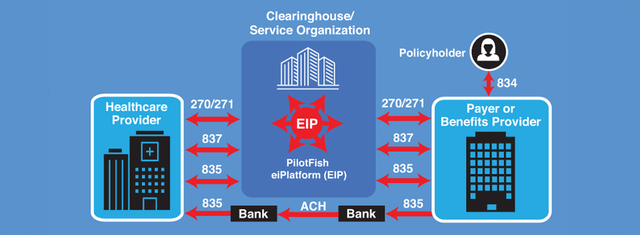Improving Data Quality and Compliance with SNIP 4+

7 Reasons Why You Need X12 EDI SNIP 4+ Level Validation
In the complex world of healthcare data interchange and regulations, the importance of adhering to the highest data validation standards cannot be overstated. As healthcare organizations continue to navigate an ever-evolving regulatory landscape, the need for rigorous data validation becomes increasingly crucial. This blog post delves into the significant benefits of upgrading to SNIP Level 4+ validation for X12 EDI transactions. This move offers not just compliance but a strategic advantage in operational efficiency and data integrity.
Here, we present seven compelling reasons why implementing SNIP Level 4+ validation is essential, ranging from enhanced accuracy and compliance to improved operational efficiencies and more insightful analytics and reporting. Join us as we uncover how these advanced validation levels can transform data management practices within your organization, paving the way for smoother processes, reduced errors and a more robust bottom line.
SNIP levels define different degrees of validation for Electronic Data Interchange (EDI) transactions within healthcare, primarily concerning data accuracy and compliance. Upgrading from SNIP level 3 validation and implementing SNIP level 4 or higher can bring many tangible benefits to an organization:
1. Enhanced Accuracy and Compliance
- SNIP Level 3 primarily focuses on balancing transaction sets and ensuring that segments are logically correct. It validates that sums of amounts within transactions, like the total claim amount, match the sum of individual elements.
- SNIP Level 4 (and higher) involves situational tests that verify that specific data elements are correctly used under certain conditions that are not strictly necessary under lower levels of SNIP. This means checking that conditional data fields are filled out correctly and only when required.
2. Reduction in Rejected Claims
By ensuring that claims are not only balanced and structurally correct (as with level 3) but also contextually appropriate (as with level 4), an organization can significantly reduce the number of claims rejected due to situational data errors. This helps in smoother processing and quicker reimbursements.
3. Improved Data Quality
Higher levels of SNIP validation lead to improved overall data quality. This is because the validation checks are more rigorous and comprehensive, ensuring that all aspects of the data are correct and appropriate for the specific transaction context. Better data quality reduces the need for rework and adjustments post-submission, leading to more efficient operations.
4. Compliance with More Complex Regulations
As healthcare regulations become more complex, higher levels of validation, like SNIP level 4 and above, help ensure compliance with these regulations. This is particularly important in environments with stringent data usage and privacy regulations.
5. Increased Trust and Reliability
Organizations that demonstrate a higher level of data integrity and accuracy are often viewed as more reliable and trustworthy by trading partners and regulators. This can enhance the organization’s reputation and open up more business opportunities.
6. Operational Efficiencies
With higher validation, the need for manual checks and corrections diminishes. This can lead to faster processing times, reduced overhead costs associated with manual interventions and improved turnaround times for claims and other transactions.
7. Enhanced Analytics and Reporting
Accurate and contextually correct data enables more precise analytics and reporting. This can provide valuable insights for decision-making and strategic planning, further improving organizational performance.

EDI Workflow Example of Clearinghouse Utilizing PilotFish Integration Platform
SNIP Levels 4+ Validation Provides Real-World Impacts
The benefits of adopting SNIP level 4+ validations are tangible, measurable and can affect a company’s bottom line. Here are some specific examples from a diverse group of organizations within the healthcare ecosystem that uncovered the impacts:
1. Enhanced Accuracy and Compliance
- In the case of a healthcare provider submitting claims for services that require prior authorization, SNIP level 4+ validation would check not only that the prior authorization number is present when needed but also that it matches the specific services billed. This minimizes compliance issues and rejections due to mismatched or missing authorization data.
- For payers processing EDI 837, SNIP Level 4+ validation can ensure that claims adhere to payer-specific requirements and protocols, reducing the risk of compliance issues and rejections related to inaccurate data submissions.
- For payers processing EDI 834 transactions, accurate validation of enrollment data, such as checking the appropriateness of plan codes and coverage dates, can minimize issues that lead to benefits being incorrectly assigned or delayed.
- A dental clinic submits EDI 837-D claims where SNIP level 4 validation checks that specific procedures requiring narratives (like unusual services) include them. This ensures compliance with payer-specific requirements.
- A mental health facility submits claims where SNIP level 4+ ensures that the session dates align with the treatment plans and that services coded are covered under the specific patient’s benefit plan, avoiding compliance issues.
2. Reduction in Rejected Claims
- A hospital submits a batch of claims for different surgical procedures. SNIP level 4 validation ensures that each claim includes required modifiers specific to each surgery type and that these modifiers match the billing codes. This prevents rejections that would typically occur if the modifiers were incorrect or missing, thereby speeding up the reimbursement process.
- For payers processing EDI 835 transactions, ensuring that payment advice details align correctly with the claims submitted (validated by SNIP Level 4+) can significantly decrease the number of rejections due to mismatched payment information or incorrect adjustments.
- For a complex surgery claim, SNIP level 4+ ensures that bundled procedures are billed correctly with primary and secondary codes, thus reducing denials due to bundling errors.
- In an outpatient setting, claims for laboratory tests include checks for necessary referring physician information and correct patient identifiers, reducing rejections for missing or incorrect information.
3. Improved Data Quality
- During the pharmacy billing process, SNIP level 4 validation checks that the drug codes submitted in the claims are not only present and correctly formatted but also appropriate for the diagnoses listed. This level of detail ensures high-quality data that reduces follow-up queries and claim denials related to mismatched diagnoses and medication codes.
- During the transfer of healthcare data between providers, SNIP level 4+ validation ensures that patient demographics are complete and accurately matched across different systems, leading to better care coordination.
- Validation of EDI 271 by payers ensures that all transmitted information is accurate and fully reflective of the subscriber’s benefits and limitations thus improving the quality of data exchanged between providers and insurers.
- In claims for durable medical equipment, SNIP level 4+ checks include validation that equipment codes match the diagnosis and severity of the patient’s condition, which improves the accuracy of submitted claims.
4. Compliance with More Complex Regulations
- With the increasing scrutiny of Medicare and Medicaid billing practices, a medical equipment supplier uses SNIP level 4+ validation to ensure that all claims meet the specific documentation requirements for reimbursement under these programs, such as the correct use of rental versus purchase codes for equipment. This helps maintain compliance with complex healthcare regulations and reduces the risk of audits and penalties.
- SNIP Level 4+ validation of EDI 277 transactions helps ensure that status notifications comply with healthcare regulations by validating that the correct and complete information about claim status is provided, thus helping to avoid penalties related to non-compliance.
- For healthcare providers handling sensitive opioid prescriptions, SNIP level 4+ validation ensures that prescriptions are compliant with state-specific regulations concerning dosage and patient monitoring requirements.
- When billing for telemedicine services, SNIP level 4+ ensures that claims include proper modifiers and comply with varying state regulations regarding telehealth, thus safeguarding against regulatory breaches.
5. Increased Trust and Reliability
- An insurance company that processes EDI claims with SNIP level 4+ validation can assure healthcare providers and regulators of its commitment to accurate and reliable data processing. This strengthens relationships with providers and enhances the insurer’s reputation in the market, potentially attracting more business partnerships.
- A specialty pharmacy uses SNIP level 4+ to ensure that all compounded medications billed comply with specific formulation requirements, thereby increasing trust among patients and providers.
- A healthcare clearinghouse that consistently applies SNIP level 4+ validation to all transactions promotes its reliability in managing accurate and compliant data exchanges, attracting more extensive provider networks.
6. Operational Efficiencies
- A sizeable multi-specialty clinic adopts SNIP level 4+ validation, which automatically corrects common errors in claims submissions, such as incorrect service location identifiers or dates of service. This automation reduces the administrative burden on staff, who would otherwise spend considerable time manually correcting these errors, thereby improving operational efficiency.
- In a pediatric practice, SNIP level 4+ validation checks ensure that immunization claims include all required documentation and correct coding, which reduces manual follow-ups and administrative workload.
- For a healthcare system implementing a new EHR, integrating SNIP level 4+ validation can preemptively correct data mismatches in patient records during the migration process, reducing the need for post-migration data cleanup.
- For payers, across all transactions, by automating deeper levels of validation (such as SNIP Level 4+), insurance companies can streamline their workflows, reduce manual data checking, and lower the administrative burden associated with corrections and re-submissions. This automation leads to faster processing times and fewer errors, enhancing overall operational efficiency.
7. Enhanced Analytics and Reporting
- A healthcare analytics firm integrates SNIP level 4+ validation into its data aggregation processes, ensuring high-quality data input for its analytical models. This level of validation ensures that the data used in predictive modeling and population health management is accurate and contextually correct, leading to more reliable insights and better decision-making support for healthcare clients.
- For a population health study, SNIP level 4+ validation ensures that all data concerning chronic conditions are accurately reported and coded, leading to more precise disease management programs.
- A health insurance company uses SNIP level 4+ validated data to calculate risk adjustment factors, ensuring that the data used is accurate and fully compliant with regulatory requirements. This enhances the precision of financial forecasts and policy pricing.
- Utilizing accurately validated data from transactions like EDI 835 and EDI 837 facilitates insurers to improve their analytics and reporting capabilities. This allows for more accurate financial forecasting, better risk management, and strategic decision-making based on reliable data insights.
Upgrading to SNIP level 4 or higher involves investing in technology and training but can provide substantial returns through improved operational performance and compliance. For organizations heavily reliant on EDI transactions, this investment can be crucial for maintaining competitive edge and operational efficiency in the healthcare sector.
PilotFish – Your Source for SNIP 4+ Validation and Code Set Maintenance
PilotFish’s offerings, specifically SNIP 4+ validation and its’ External Code Set Maintenance Program, are perfectly aligned to help organizations elevate their EDI transaction processes. By adopting SNIP Level 4+ validation, organizations can significantly improve their data’s accuracy, compliance, and quality. This advanced level of validation ensures that data fields are correctly filled and contextually appropriate, leading to reduced claim rejections and enhanced operational efficiency. Learn how each SNIP Level 1-7 is handled in PilotFish.
Watch the demo of PilotFish’s eiSuite EDI SNIP4+ with SNIP 1-7 validation
and optional code set maintenance.
PilotFish’s maintenance service ensures that all EDI standards are current, further supporting compliance with complex healthcare regulations. Through these tools, PilotFish not only simplifies the technical challenges of EDI transactions but also empowers healthcare organizations to achieve better data management, smoother claim processes and overall improved performance. By leveraging PilotFish’s solutions, healthcare and insurance entities can reap substantial benefits, such as increased trust and reliability, greater operational efficiencies and more precise analytics and reporting. They can enhance their competitive edge in a demanding industry.
If you have any additional questions or require further assistance, please don’t hesitate to contact our customer support team. Click on the button or jump into a chat.
X12, chartered by the American National Standards Institute for more than 35 years, develops and maintains EDI standards and XML schemas.
